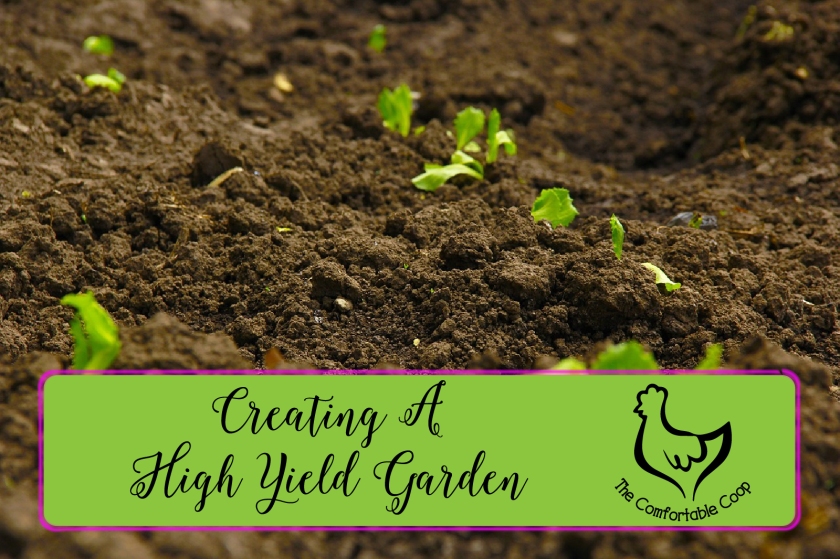The cost of groceries has been skyrocketing lately. It seems that every week prices have gone up considerably while income stays the same for most of us. Growing your own food, as much as possible, is an alternative to buying expensive produce. And if you’re growing your own produce you can control what you’re eating. By using heirloom seeds you can avoid GMO produce; this is the stuff known as “Frankenfood.” You can also avoid the use of pesticides that kill honey bees and other beneficial insects and use natural fertilizers. These tips can help you in creating a high yield garden that will help you save money and feed your family better food.

Soil is key – I have a relatively small garden. It’s 25’ x 25’ but I leave a 2 foot border all the way around so no rabbits can sit outside the fence and munch on the leaves of my vegetables. This leaves me a 23’ x 23’ foot space in which to grow all our vegetables; and deducted from that space are the paths I need to walk on inside the growing space. You should avoid walking on the soil except from paths. Since I grow as many vegetables as possible my garden is planted intensively.
Here’s how I prepared the area:
After lifting all the sod in the area I’d planned for the garden we went through and removed as many rocks as we could (they grow here better than any crop so each year more are heaved up by freeze/thaw cycles). I pulled out roots from the grass and weeds that had grown there. When the ground was prepared we added about 6 inches of compost. You can also use well-rotted manure. I didn’t get the soil tested but I wish I had. You want a neutral pH level.
In the spring: We use a rototiller to break up the soil which tends to get a bit compacted over the winter. This also aerates a few inches of the soil. We tend to have wet springs and I don’t want soggy soil so working it helps dry it out. I add a bit more compost but if you have your soil tested you may find it doesn’t need amending. Since we have generally very cold winters here, I warm the soil in the spring by covering it with black plastic. I can even set some plants out a bit early if I cover them with a plastic “tunnel” in the warmed soil. If you warm the soil and set out plants be sure to cover the plastic with mulch when you put the plants in so the soil won’t get too warm.
Planting: One way I save time and ensure healthier plants is by spacing plants as closely together as allowed. The foliage from the plants I want shades any weeds that pop up and stunt their growth. Avoid spacing plants too closely together, though. Crowded plants are more susceptible to diseases. By simply adding a couple of inches between some plants I’ve found the yields increase greatly.
I also grow some things vertically. My pickling cucumbers, zucchini, and baby watermelons are all on trellises, as are my pole beans, English peas, and sugar snap peas. The tomatoes and pepper plants are all grown with cages and stakes to support them in their upward growth. By planting in triangles rather than rows you can increase the yield considerably. You’ll be able to fit about 10% more plants in the same area.
Companion planting also saves space. The Native Americans called corn, beans, and squash the “three sisters.” Pole beans use the corn stalks for support and the squash can grow freely under the corn. Another great thing about companion planting is that many companions deter harmful insects from vulnerable neighbors or attract beneficial insects.
In addition to using companion planting to utilize space most efficiently, you can increase your yield by succession planting. This means that you use the same garden space for successive plantings of different crops. You can plant an early lettuce, then a fast-maturing corn, then another planting of lettuce in the same area. You can also plant things that will overwinter in the ground. Garlic is one crop that can be planted about 6 – 8 weeks before the first frost and left in the garden all winter. Be sure to give the soil a boost of compost if you succession plant. You only need 1/4 to 1/2 inch worked into the soil between each successive planting.
If you use raised planting beds you can gently round the tops to increase your planting space. If you have a 5 foot bed and round the top you end up with a 6 foot arc.
During the season: If I harvest everything from an area (which, frankly, doesn’t happen often) I spread a little compost and just rake it in about 2 inches. I only put about 1/2 inch or so of compost. I use a pitchfork to aerate that area. I kind of poke the soil all over as though I’m tenderizing meat.
Late in the season: I plant a last, late crop of leaf lettuce, spinach, and kale. If you’re going to plant late season crops or even for succession planting, start the plants before they’re going to go in the garden. I generally start them so they’re a month or so old when I put them in.
At the end of the season: I spread more compost, about 2 inches or so, on every area that is done for the season. I don’t even work it in. It will work itself into the soil.
These are the ways I get a higher yield from my garden. If you use these or other methods I’d love to hear from you!


